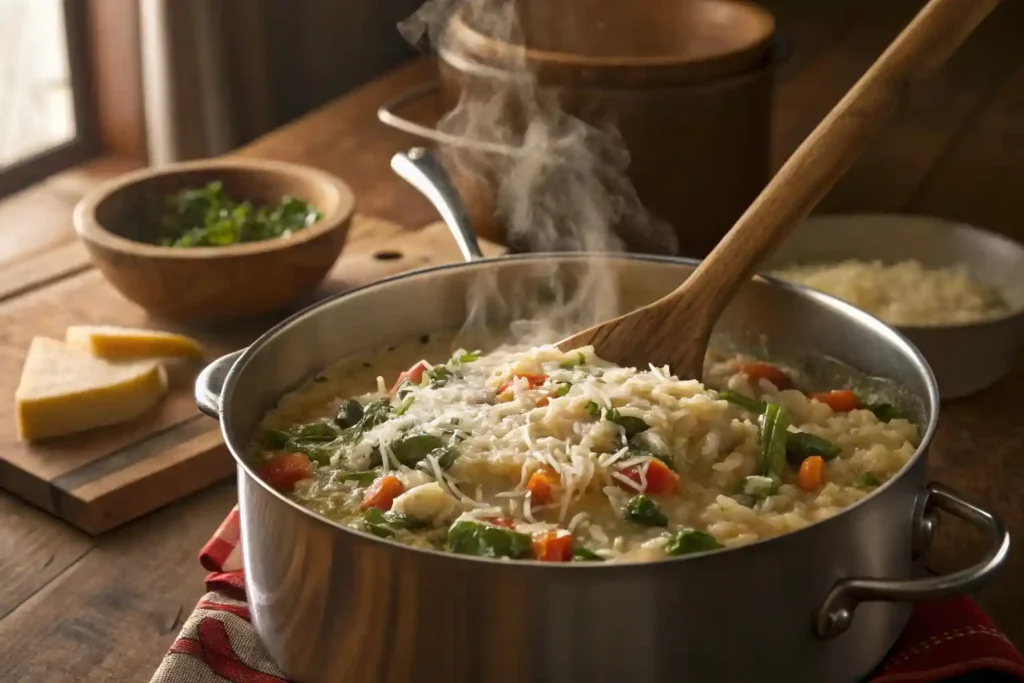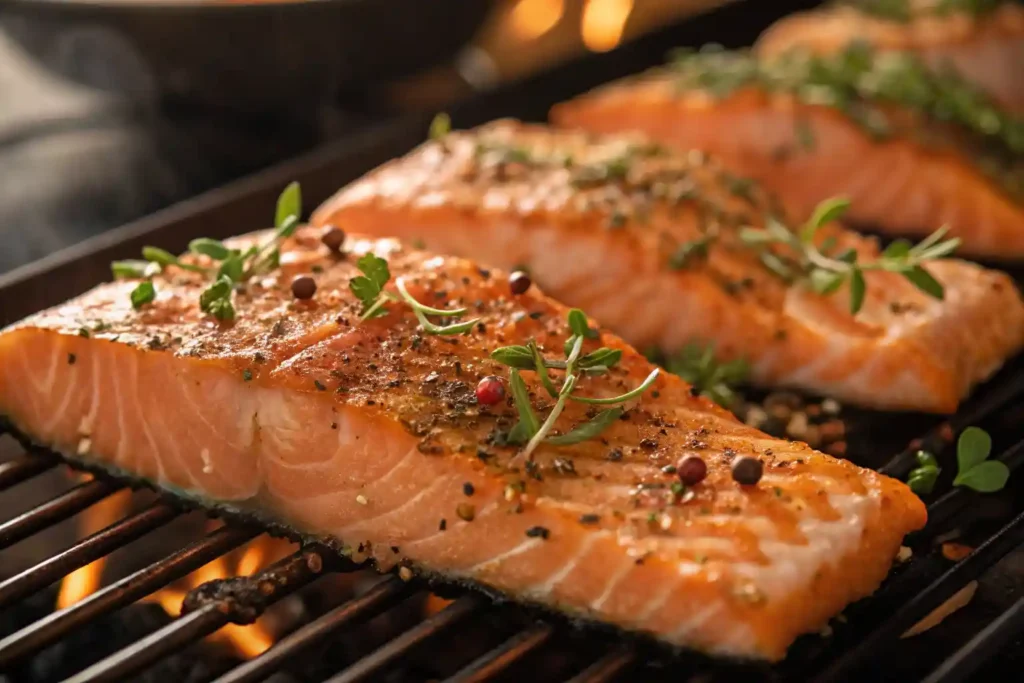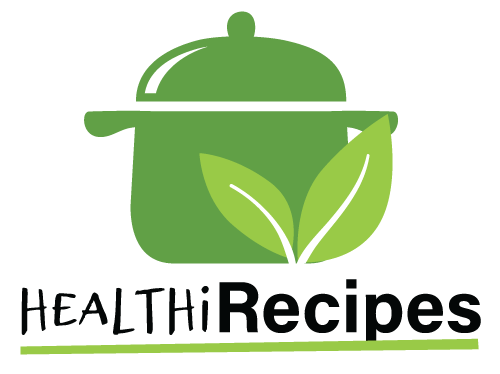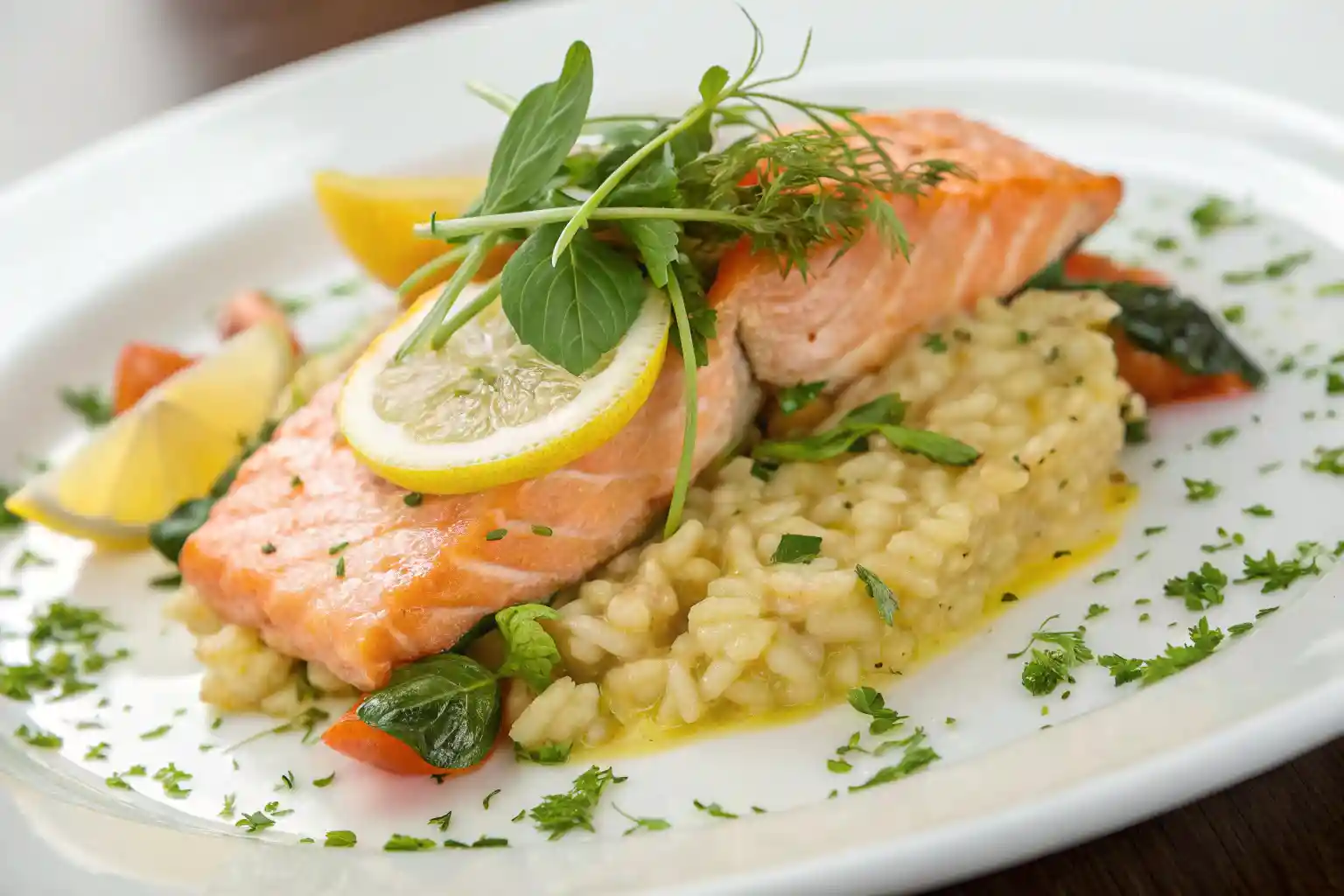When it comes to comfort food, few dishes can compete with the creamy goodness of salmon and risotto. This delightful combination not only warms the heart but also tantalizes the taste buds. In this article, we’ll explore everything you need to know about making the perfect salmon risotto, from selecting the right ingredients to cooking techniques that ensure a delicious outcome. We’ll also dive into variations, nutritional benefits, and pairing suggestions to elevate your dining experience. So, let’s get started on this culinary journey!
Table of contents
1: Introduction to Salmon Risotto
What is Salmon Risotto?
Salmon and risotto is a classic dish that brings together the rich flavors of salmon with the creamy texture of risotto. Risotto, an Italian rice dish, is known for its creamy consistency, achieved by slowly cooking Arborio rice in broth while stirring continuously. When you add succulent pieces of salmon, you create a meal that’s not only satisfying but also packed with flavor.
Why Salmon and Risotto Make a Perfect Pair
The beauty of salmon and risotto lies in their complementary qualities. The buttery richness of salmon pairs beautifully with the creamy, starchy risotto, creating a harmonious balance on your plate. Plus, salmon is a fantastic source of omega-3 fatty acids, making this dish not just delicious but also nutritious. Whether you’re cooking for a special occasion or a cozy weeknight dinner, this combination is sure to impress.
2: Ingredients for the Perfect Salmon Risotto
Essential Ingredients for Salmon Risotto
To whip up a delicious salmon and risotto, you’ll need a few key ingredients. Here’s what you should gather:
- Arborio Rice: This short-grain rice is essential for creating that creamy texture. It absorbs liquid beautifully while releasing starch, making your risotto rich and velvety.
- Fresh Salmon: Opt for skinless salmon fillets. You can use wild-caught or farmed salmon, depending on your preference. The fresher, the better!
- Broth: Chicken or vegetable broth works well. Homemade broth is ideal, but store-bought is perfectly fine too. It adds depth to the flavor.
- Onion and Garlic: These aromatics are crucial for building flavor. Finely chop them to release their natural sweetness.
- White Wine: A splash of dry white wine enhances the dish’s flavor. It’s optional, but it adds a lovely acidity.
- Parmesan Cheese: Freshly grated Parmesan adds creaminess and a savory kick.
- Butter and Olive Oil: A combination of both gives richness and helps in sautéing the onions and garlic.
- Herbs: Fresh parsley or dill can brighten up the dish.
Optional Ingredients to Enhance Flavor
While the above ingredients are essential, you can also consider adding:
- Vegetables: Peas, asparagus, or spinach can add color and nutrition.
- Lemon Zest: A hint of citrus can elevate the flavors.
- Cream: For an extra creamy risotto, a splash of heavy cream can be added at the end.
With these ingredients in hand, you’re ready to create a delightful salmon and risotto that will impress anyone at your dinner table!
3: Step-by-Step Guide to Making Salmon Risotto

Preparing the Base: Cooking the Risotto
Now that you have your ingredients, let’s dive into the cooking process. Making salmon and risotto is a labor of love, but the results are worth it!
- Heat the Broth: Start by warming your broth in a saucepan over low heat. Keeping it warm will help the rice cook evenly.
- Sauté Aromatics: In a large skillet, heat a tablespoon of olive oil and a tablespoon of butter over medium heat. Add the chopped onion and garlic, cooking until they’re soft and translucent, about 3-4 minutes.
- Toast the Rice: Add 1 cup of Arborio rice to the skillet. Stir it around for about 2 minutes until the rice is lightly toasted. This step enhances the nutty flavor of the rice.
Cooking the Salmon: Techniques and Tips
- Deglaze with Wine: If you’re using white wine, pour in about ½ cup now. Stir until the wine is mostly absorbed. This adds a wonderful depth of flavor.
- Add Broth Gradually: Begin adding the warm broth, one ladle at a time. Stir frequently and allow the rice to absorb the liquid before adding more. This process should take about 18-20 minutes. The rice should be creamy and al dente when done.
- Cook the Salmon: While the risotto is cooking, heat another skillet over medium heat. Add a bit of olive oil and season your salmon fillets with salt and pepper. Cook for about 4-5 minutes on each side, or until the salmon is cooked through and flakes easily with a fork. Remove from heat and set aside.
Combining Ingredients: Achieving the Perfect Texture
- Combine Salmon and Risotto: Once the risotto is creamy and the rice is cooked, gently fold in the cooked salmon. Break it into bite-sized pieces as you mix.
- Add Cheese and Butter: Stir in ½ cup of grated Parmesan cheese and another tablespoon of butter for extra creaminess. Mix until everything is well combined.
Final Touches: Seasoning and Serving Suggestions
- Season to Taste: Taste your risotto and adjust the seasoning with salt and pepper. If you like, add a bit of lemon zest for brightness.
- Garnish and Serve: Serve your salmon and risotto hot, garnished with fresh herbs like parsley or dill. A sprinkle of extra Parmesan on top never hurts!
4: Variations of Salmon Risotto
Vegetable Additions for a Healthier Dish
While the classic salmon and risotto is delicious on its own, you can easily enhance it by adding vegetables. Incorporating greens not only boosts the nutritional value but also adds vibrant colors to your dish. Here are some great options:
- Peas: Sweet peas are a fantastic addition. They cook quickly and add a pop of color and sweetness.
- Asparagus: Cut asparagus into bite-sized pieces and add them during the last few minutes of cooking. They provide a nice crunch and earthy flavor.
- Spinach: Stir in fresh spinach just before serving. It wilts quickly and adds a lovely green hue along with extra nutrients.
Different Types of Salmon to Use
When it comes to salmon and risotto, the type of salmon you choose can make a difference in flavor and texture. Here are a few options:
- Wild-Caught Salmon: Known for its rich flavor and firmer texture, wild-caught salmon is a great choice if you want a more robust taste.
- Farmed Salmon: This is often more affordable and has a milder flavor. It’s a good option for those who prefer a softer texture.
- Smoked Salmon: For a unique twist, consider using smoked salmon. It adds a delightful smoky flavor that pairs beautifully with the creamy risotto.
Feel free to experiment with these variations to create your perfect salmon and risotto dish!
5: Nutritional Benefits of Salmon and Risotto

Health Benefits of Salmon
Salmon and risotto not only satisfy your taste buds but also deliver numerous health benefits. Packed with essential nutrients, salmon serves as a powerhouse of nutrition. Here are some key benefits:
- Rich in Omega-3 Fatty Acids: These healthy fats support heart health, reduce inflammation, and enhance brain function.
- High in Protein: Salmon provides an excellent source of high-quality protein, essential for muscle growth and repair.
- Vitamins and Minerals: Salmon contains abundant vitamins B12 and D, along with selenium, which play vital roles in energy production and immune function.
Nutritional Value of Risotto
While many view risotto as a comfort food, it can also contribute to a nutritious meal. Here’s what makes risotto a smart choice:
- Carbohydrates: Arborio rice offers a solid source of carbohydrates, essential for energy. This benefit is especially important for those with active lifestyles.
- Fiber: By adding vegetables to your risotto, you boost its fiber content, aiding digestion and helping you maintain a healthy weight.
- Versatility: You can customize risotto with various ingredients, allowing you to incorporate different nutrients based on your dietary needs.
6: Pairing Suggestions for Salmon Risotto
Best Sides to Serve with Salmon Risotto
When it comes to enjoying salmon and risotto, the right side dishes can elevate your meal to a whole new level. Here are some fantastic options to consider:
- Steamed Vegetables: Lightly steamed veggies like broccoli, green beans, or carrots add color and nutrition. They provide a nice contrast to the creamy risotto.
- Salad: A fresh salad with mixed greens, cherry tomatoes, and a light vinaigrette can balance the richness of the risotto. Consider adding avocado for creaminess and healthy fats.
- Garlic Bread: For a comforting touch, serve some warm garlic bread on the side. It’s perfect for soaking up any leftover risotto.
Wine Pairings for a Complete Dining Experience
Pairing the right wine with your salmon and risotto can enhance the flavors of both the dish and the drink. Here are some excellent wine choices:
- Sauvignon Blanc: This white wine is crisp and refreshing, making it a great match for the richness of salmon. Its acidity complements the dish beautifully.
- Chardonnay: A lightly oaked Chardonnay can add a creamy texture that pairs well with the risotto. Look for one with balanced acidity to avoid overpowering the flavors.
- Pinot Noir: If you prefer red wine, a light-bodied Pinot Noir can work surprisingly well. Its fruity notes and low tannins won’t overshadow the delicate flavors of the salmon.
By choosing the right sides and wine, you can create a well-rounded meal that highlights the deliciousness of salmon and risotto.
7: FAQs About Salmon and Risotto
What Meat Pairs Best with Risotto?
While salmon and risotto is a classic combination, other meats can also complement risotto beautifully. Chicken, especially grilled or roasted, works well. Additionally, shrimp or scallops can add a seafood twist. For a heartier option, consider using braised meats like short ribs or lamb.
What Are Good Sides with Salmon?
When serving salmon, you have plenty of side options. Roasted vegetables, such as asparagus or Brussels sprouts, are excellent choices. You can also serve it with a light salad or a grain-based dish like quinoa or couscous. These sides enhance the meal without overwhelming the flavors of the salmon.
Why Is Salmon and Rice So Good?
The combination of salmon and rice is delightful due to the balance of flavors and textures. Salmon’s rich, buttery taste pairs perfectly with the creamy, starchy texture of risotto. Additionally, both ingredients are versatile, allowing for various seasonings and additions that can enhance the overall dish.
What Is Traditionally Served with Risotto?
Traditionally, risotto is served as a first course in Italian cuisine. It can be paired with a variety of proteins, including seafood, chicken, or vegetables. Often, it’s garnished with fresh herbs or cheese to add flavor. In the case of salmon and risotto, the fish becomes the star of the dish, making it a satisfying main course.
Conclusion
In conclusion, salmon and risotto is a delightful dish that combines rich flavors and creamy textures, making it a favorite for many. By experimenting with various ingredients, such as adding vegetables or trying different types of salmon, you can create a unique version that suits your taste. Pairing this dish with sides like steamed vegetables or a fresh salad enhances the overall experience. For those looking for more salmon inspiration, check out our Pumpkin Risotto with Beans for a different take on this comforting dish. Additionally, if you want to explore another delicious take on this classic, visit BBC Good Food for their take on salmon risotto. Enjoy your culinary journey with this versatile dish, and don’t hesitate to try out different variations to find your perfect combination!

